The Asian
Giant Hornet
Vespa
mandarinia Smith, 1852
click
on thumbnails to enlarge the images
The species Vespa
mandarinia is a very large-sized wasp with a Body length 27 - 45 mm;
unbelievable, the queens reach 5.5 cms in length!
Distribution:
SE part of Asian Russia: southern regions of Primorskii Krai, Korea, China, Indochina, Nepal, India (Kurzenko, 1995), Shri Lanka, Thailand,
Japan (In Japanese:
Ohsuzumebati).
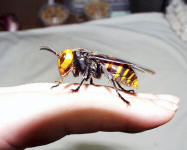
Photo: Takehiko Kusama; found in
Niigata - Japan
The Head is orange rather wide than
long; the compound eyes and ocelli are dark brown; antennae dark brown with orange
scapes, mandible orange with black tooth.
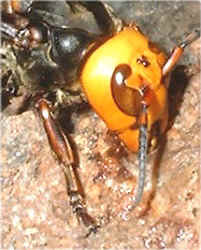 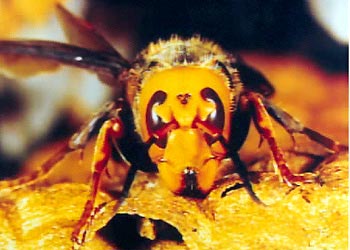
Photos: ikimono@sci.nhk.or.jp
The clypeus is orange coarsely punctured and posterior side of clypeus with narrow
rounded lobes.
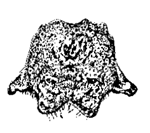
Clypeus
Photo: Sirinee Poonchaisri
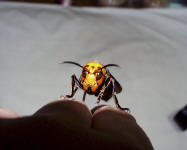
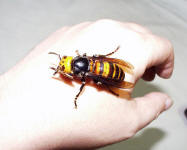
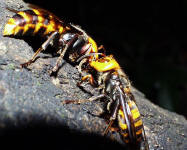
Photos: Takehiko Kusama; found in
Niigata - Japan
Thorax and propodeum with golden
tint, scutellum large with a medial deeply-impressed line, postscutellum bulging and overhanging
the propodeum, beneath the postcutellum in transverse hollow produced triangularly down
from the middle and continued as a medial furrow to the apex of the propodeum.
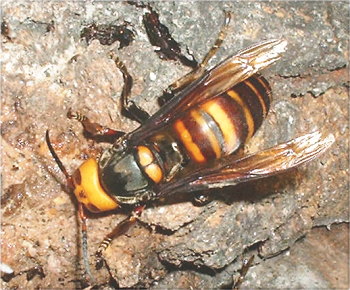
Photo: ikimono@sci.nhk.or.jp
Forelegs are orange with dark brown tarsi, the mid- and hind
legs dark brown. Wings are fuscous brown; tegulae also brown.
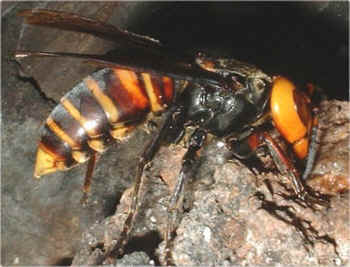
Photo: ikimono@sci.nhk.or.jp
Gaster pruinose, dark brown; with narrow yellow bands at the
posterior margins of
the tergite, the sixth segment is entirely yellow.
Additional this gigantic, voracious predator
has a quarter-inch stinger (6.35mm)! People are usually not the Japanese
giant hornet's prey, but those who have felt its sting describe the pain as
excruciating and very painful. Masato Ono, an entomologist at Tamagawa
University, near Tokyo, said it's "like a hot nail through my leg."
Vespa
mandarinia is easily recognized by the head which is strongly widened
and produced behind the compound eyes, first to fifth of gastral segments dark
brown; with narrow yellow bands at the margins of the tergites, sixth segment
entirely yellow.
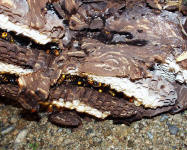
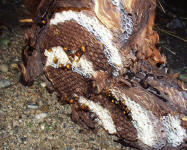
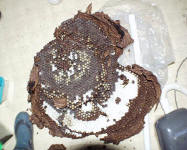
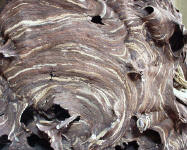
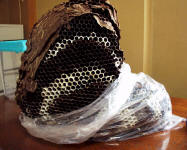
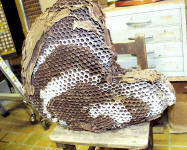
Photos: Takehiko Kusama; found in
Niigata - Japan
This is a very
interesting topic:
Bees handle invading wasps by 'baking' them alive!
-
The Japanese
Honeybee's Thermal Defense
The Japanese giant hornet, Vespa
mandarinia japonica, preys on other species of bees and wasps.
When a solitary hunter finds a nest, it marks it with a secretion from its van der
Vecht gland. Other hornets in the area congregate to the area, and they
begin a mass attack on the colony. While they are efficient at wiping out
hives of the introduced European honeybee Apis mellifera (they
are killed at rates as high as 40 per minute), the native Japanese
honeybee, Apis cerana japonica, has an interesting defense against the
predatory hornet! The Japanese honeybees can detect the hornet's secretion, and attack
incoming hornets en masse. With approximately 500 honeybees surrounding the
hornet in a tight ball, the temperature within the cluster rises to 47º C (117º F), which is above
the upper lethal limit range of 44-46 degrees for the hornet.
This temperature is too high for the hornet, which quickly expires, but does
not harm the honeybees.This temperature does not aversely affect the honeybees because their upper
lethal limit is slightly higher, 48-50 degrees.
You can read more about
this here:
-
Heat
production by balling in the Japanese honeybee, Apis cerana japonica as a
defensive behavior against the hornet (Vespa mandarinia japonica).
Publisher: Experientia, 43, 1987; Author: M. Ono, I. Okada & M. Sasaki
-
Unusual
thermal defense by a honeybee against mass attack by hornets (Vespa
mandarinia japonica).
Publisher: Nature, 377, No. 6547, 1995; Author M. Ono, T. Igarashi, E. Ohno
& M. Sasaki
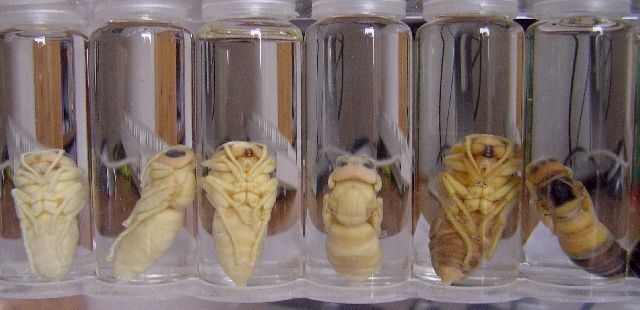
Fotos: Dieter Kosmeier
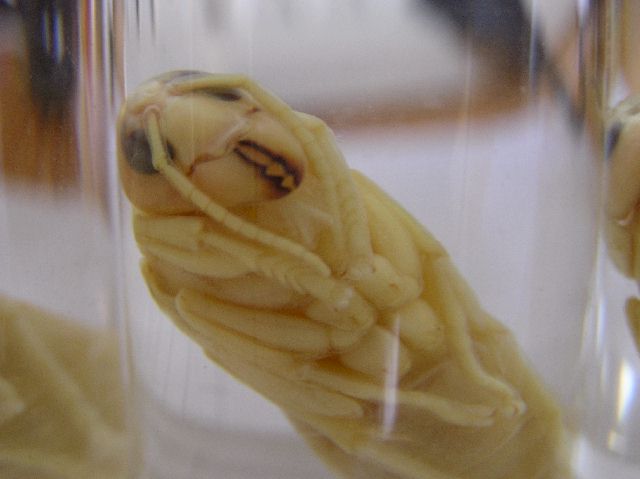
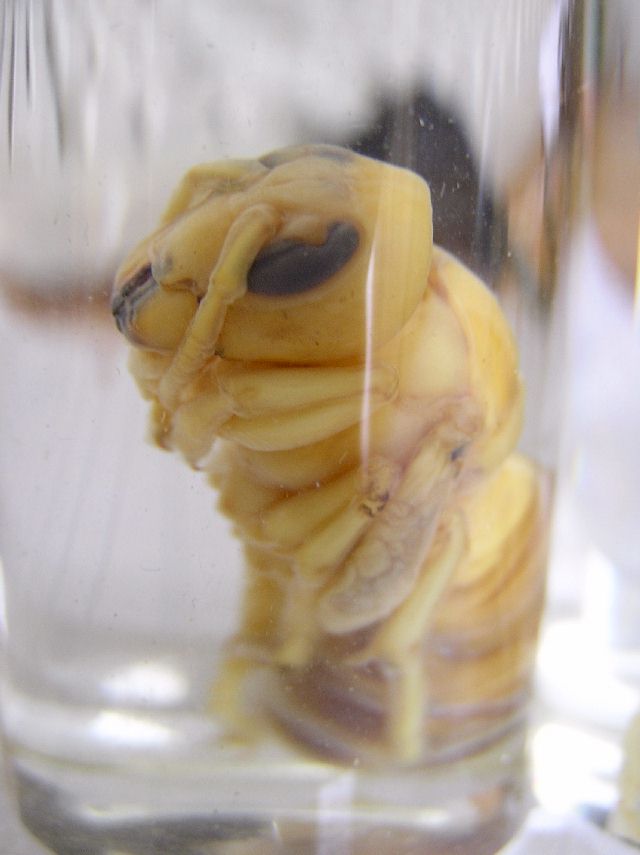
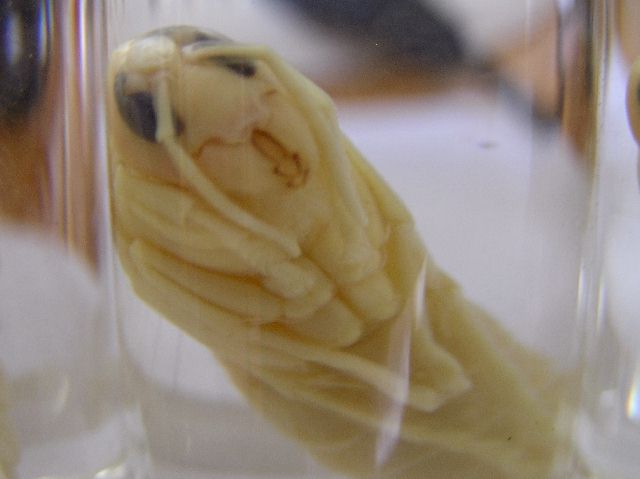
A usual work of a
Beekeeper in Japan is protecting the Honeybees from Hornets in Autumn
Japanese wasps appear usually after the middle of August. The types most
often seen at the bee farm are Vespa mandarinia, Vespa analis
insularis and Vespa simillima Smith. The Vespa simillima Smith only catch
honeybees one at a time, roll them into a ball, and then carry them away. But the Vespa mandarinia attack and crush honeybees one after another
with their mandibles until all the honeybees are wiped out, then carry away all of the larvae.
Example of an attack:
If a colony of about 30.000 European honeybees (Apis mellifera) were to be attacked by 30 giant hornets (Vespa
mandarinia japonica) they would be wiped out in 3 hours. The hornets would enter the nest, kill the bees, and take their bodies home to their young.
After a few successful trips, hornets rub a pheromone on the nest that signals other hornets to attack.
So in
autumn, most beekeepers in Japan think it is quite normal, that measures are
needed to protect the honeybees from these natural enemies. They attach very
often a wasp trap to the front of the hive entrance.
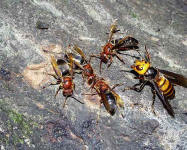
Photo: Takehiko Kusama; Vespa
mandarinia against Vespa dybowskii
Vespa mandarinia - dark colour
form.
The head is bright orange, the abdomen black with
very very thin orange bands, and again a bright orange tip (where the stinger
comes out). It likes also to hover outside beehives, and eat the honeybees.
Photos from India, at altitude 6,500 feet in
Uttarakhand - known around there as "Tiger Bee".
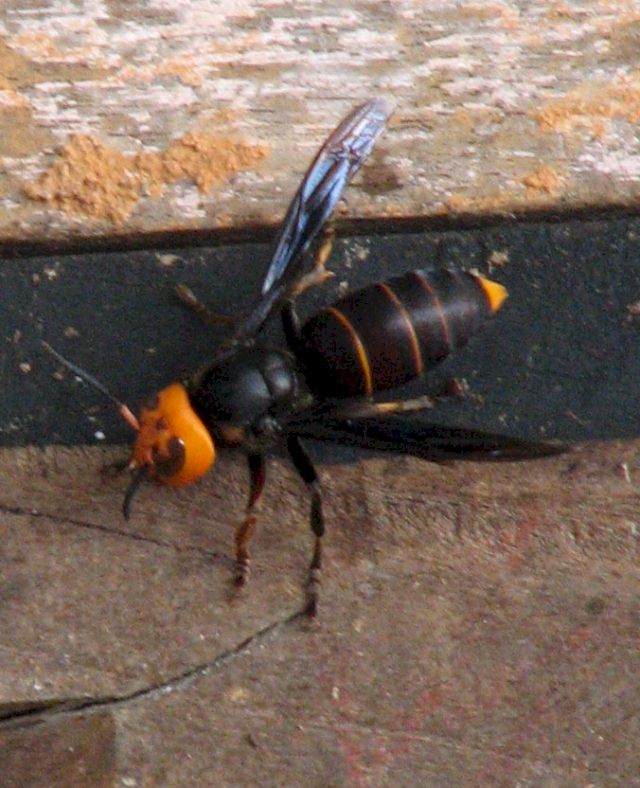
Photos:
a friend from the Himalayas
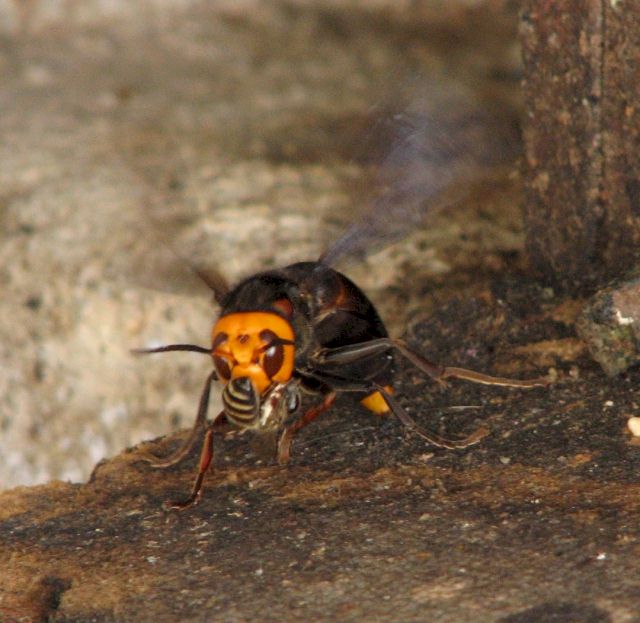
The hornet above has a bee (probably Apis cerana)
in its jaws. It was taken with a good zoom lens. The hornet didn't seem to be at
all disturbed by the presence of the photographer, interested only in catching a
bee. Though once he did charge his hand (when he was coming in close for a macro
shot). It takes between 5 seconds and two minutes to catch a bee, depending
perhaps on the number of bees present and its luck.
The pair of the 2 stalkers was taken
before, with macro lens, very close range
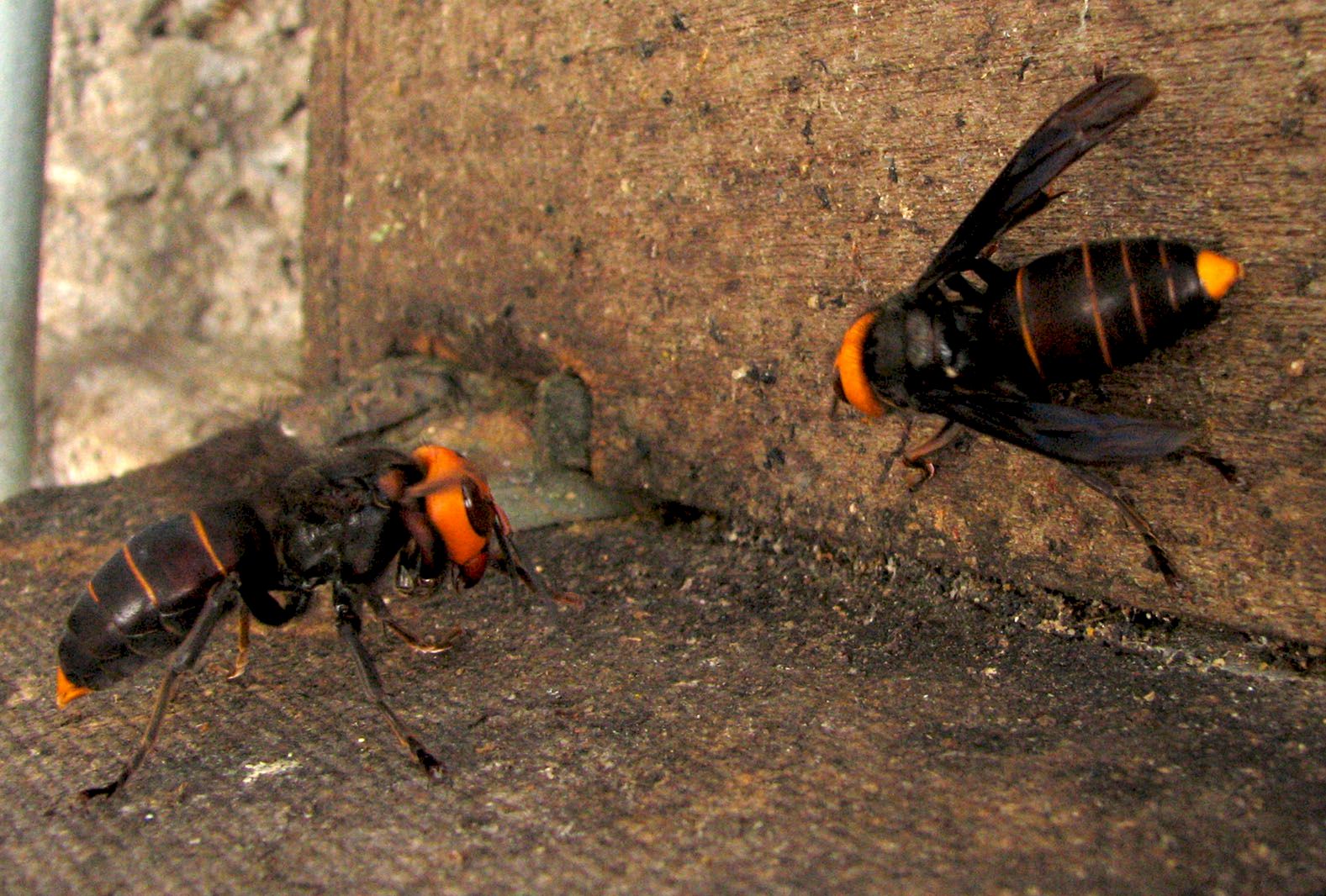
The toxicity ...
"three hornet stings will kill a man"
The toxicity of Vespa mandarinia venom is
actually somewhat lower than that of honeybee (Apis mellifera) venom. The
median lethal dose (LD50), a dose at which 50% of subjects will die, is 4.1 mg
venom per kg body weight (injected in vitro in mice) for Vespa mandarinia
and 2.8 mg/kg for honeybee venom. Whereas the honeybee is more toxic, the much
larger hornet usually injects a greater quantity of venom, so a hornet sting may
be in fact a bit more dangerous. But given the fact, that humans will usually
survive several dozen or even hundreds of bee stings without lasting
consequences, it becomes evident that claims like "three hornet stings will kill
a man" are nonsense. No healthy man dies from only three Vespa mandarinia stings!
-
Vespa mandarinia japonica
4,1mg
-
Vespa simillima xanthoptera
3,1mg
-
Vespa tropica
2,8mg
-
Vespa luctuosa
1,8mg
-
Apis mellifera
(Honeybee)
2,8mg
Yellow Hornets
Yellow Hornets (Vespa simillima Smith, 1868)
are common in Asian Russia and adjacent territories and Japan. It is not the
same species as the big hornet (Vespa mandarinia). The yellow-hornet makes
greyball-shaped nests built on structures or in trees. Beekeeper don't like them,
because when a yellow hornet approaches to the nest of the Japanese honeybee in
the loft, the yellow hornet kills them one by one, hovering near the entrance in
the air. But there are so many honeybees in the nest, it is not a big damage for
them.
Faster Than a
Speeding Hornet!? :-)) NYTIMES
January 3, 2001; By
STEPHANIE STROM TOKYO -- WHEN Naoko Takahashi flew to a
record-breaking victory in the women's Olympic marathon in Sydney, Australia,
last September, she had the power of tiny wings working for her. Miss Takahashi,
like many Japanese long-distance runners, is a devotee of a little-known drink
that its proponents believe may revolutionize sports requiring endurance and
rigorous training. Sold here under the brand name Vaam, the concoction contains
a synthetic version of the juice that gives Japan's giant hornets the strength
to fly distances of about 60 miles a day at speeds of almost 25 miles an hour.
This drink is very effective in sustaining stamina and energy, said Yoshio Koide,
Miss Takahashi's coach and perhaps the biggest proponent of Vaam's benefits. "I
had tried everything before tea, lemon tea, honey but nothing worked very well."
Mr. Koide does not have much of a track record to support his conviction that
Vaam gives his athletes an edge, and what scientific evidence of the benefits
there is comes from tests done with mice.
Of course, supplements purporting to
enhance athletic performance are nothing new. Gatorade started out in the 1960's
as an electrolyte drink aimed at helping athletes sustain their vigor by
replacing potassium and sodium lost in sweat. In the 1970's, bee pollen was a
fad among American sprinters who believed it gave them a spurt of energy. Yuko
Arimori, an Olympic medal- winning marathoner, said that she had tried the
pollen, but it tasted terrible and had no benefits that she could detect.
In
1993 and 1994, Chinese women whose coach claimed they ate worms and soup made
from the blood of soft-shelled turtles trained by running up to 22 miles every
day and broke world distance records at an astounding pace. The world was never
really sure whether it was the turtle and worm diet or drugs that produced those
victories. Several Chinese runners were later suspended after testing positive
for drugs. Craig Masback, a former world-class miler in the United States, said
that his parents would remind him as a child to eat candy bars for energy before
races. Then his high-school coach recommended dextrose tablets, while Lee Evans,
the Olympic 400-meter champion, told him to eat raisins before competition "because
it is a fruit with a burst of sunlight."
Lasse Viren, the Finn who was accused
of blood doping after his Olympic victories in 1976, said reindeer milk was the
secret of his long-distance greatness. "This is just symptomatic of people always
looking to supplement their diet with something that will either actually or
with perception enhance performance," said Mr. Masback, who ran the mile in 3
minutes 52.02 seconds in 1979 and now is the chief executive of USA Track &
Field, America's national governing body for the sport. But Takashi Abe, the
scientist at the Institute of Physical and Chemical Research whose work
uncovered what he says are the benefits of the hornet liquid used in Vaam,
insists that the drink that Miss Takahashi uses is different.
"Things like
Gatorade seek to replace electrolytes and other things lost during athletic
performance," said Dr. Abe, who worked for several years at research institutes
in the United States. "They add things to the body in an effort to give it more
energy to burn, but Vaam works by helping the body burn the energy it already
stores more efficiently." Top athletes in Japan say the drink works wonders in
preventing dehydration, maintaining energy levels and preventing fatigue. "About
half an hour after I drink it, I can feel energy penetrating all of my muscle
groups," said Ms. Arimori, who won a silver medal in the marathon at the
Olympics in Barcelona, Spain, in 1992 and a bronze four years later in Atlanta
under Mr. Koide's coaching. "In Atlanta in 1996, shortly after the 30-kilometer
mark, I got really dehydrated, but I drank Vaam and felt much better."
"Water
makes you thirsty soon after you drink it, but if I drink Vaam, I can run 5 or
10 kilometers without needing to drink any further." Ms. Arimori has appeared in
advertisements for the product, which is made by the Meiji Milk Products
Company, but does not claim it is a cure-all or say it guarantees victories. "It's
mostly good for training for long-distance races and other endurance sports,"
she said. "It's not for every athlete. I don't think it would be that effective
for a gymnast, for instance." Ms. Arimori, Dr. Abe and others conceded that some
of the drink's benefit might be psychological. "I think there is also a mental
element to Vaam, but that's important in sports, too," Ms. Arimori said. Vaam,
which stands for vespa amino acid mixture, contains the same amino acids that
are in the liquids secreted by hornet larvae.Those liquids are the sole diet of
adult hornets, known scientifically as Vespa mandarinia, whose wings flutter up
to 1,000 times a minute and are strong enough to lift objects weighing more than
six pounds even though worker hornets weigh only 0.09 ounce on average. Dr. Abe
said the amino acids generated by the larvae set off a mechanism that converts
fat to fatty acids that can be burned for energy. Typically, the human body
burns glycogen to produce energy, but because it stores only about 1,800
calories worth of glycogen, the supply runs out quickly. Thus, marathoners and
athletes in other endurance sports constantly seek to replenish their stores of
glycogen with supplements. The body contains far bigger reserves of fat, about
27,000 calories' worth in the average 132-pound person. But the body has far
more trouble burning fat than glycogen and thus burns glycogen first. Vaam
expedites the metabolism of fat and also promotes better hydration of the body,
Dr. Abe said. Burning fat produces sweat Ms. Arimori and the boxer Hong Chang Su
both said that Vaam makes them sweat quite heavily and thus improves hydration,
Dr. Abe said. "We have a lot of fat inside our bodies, and usually we can't use
it unless we're starving," he said. "These amino acids can help us make use of
our stores of fat." Meiji, which produces Vaam, has yet to tap what may be the
biggest market for the drink: dieters. Shinro Sugiura, president of the Aerobics
and Fitness Association of America Japan, said Vaam had several devotees among
members of the Azusawa Garden Sports Club. Azusawa, which serves as the fitness
association's headquarters, features vending machines with the drink in the
locker rooms. "Most people work out to lose weight and stay in shape," Mr.
Sugiura said. "Vaam acts as an accelerator in helping the body burn fat." Dr.
Abe said he had even used it to prevent and cure hangovers. "The liver function
during alcohol intoxication is improved by Vaam," he said. "If I drink Vaam
before drinking alcohol, I don't have nearly such a bad hangover as I do when I
don't drink it." The drink does not seem to run afoul of international sports'
doping rules, although no athletic body has asked to test Vaam. "My runners were
all tested in Sydney," Mr. Koide said. "They all drink Vaam, and none of them
tested positive for doping." Studies conducted by Dr. Abe showed that mice that
drank Vaam could swim almost twice as long as those drinking only water, and 25
percent longer than those drinking supplements containing casein, a protein
found in milk. The blood of the mice drinking Vaam contained fewer fatty acids,
an indication of how efficiently the body is burning fat, than that of mice
drinking casein, glucose or water, the studies showed. The level of lactic acid,
which tends to rise as the body burns glucose and can lead to muscle cramps, was
also far lower in the blood of mice drinking Vaam than in that of the other mice,
according to the studies. Ms. Arimori and Mr. Sugiura said that Vaam's price a
6.7-ounce can costs about $2.20 at current exchange rates, compared with other
sports drinks that cost about $1.58 has inhibited sales. Meiji would like to
sell Vaam in other parts of the world, said Masayoshi Shimbo, the company's
executive in charge of selling the drink. Mr. Sugiura has been promoting the
drink in Taiwan and Hong Kong. But Meiji may never be able to tap the United
States market. Vaam contains a small amount of tryptophan; sales of dietary
supplements containing L-tryptophan were prohibited in the United States after a
1989 outbreak of eosinophilia-myalgia syndrome, or E.M.S., a potentially fatal
disease of the immune system. Dr. Abe said attempts to eliminate tryptophan from
Vaam have so far proven unsuccessful. Coaches and athletes stress that the
biggest benefit of the drink is the ability to train longer and harder. "For
boxing, which is a rapid sport with short, quick movements, not an endurance
sport, it's not so effective," said Hong Chang Su, the boxer known in the ring
as Masamori Tokuyama and the World Boxing Council's super flyweight champion. "But
when I was training, I drank it every morning because I have lots of road work
and jogging, and it helps me maintain endurance and energy." His trainer, Hideo
Kanazawa, admits that Vaam is a bit of a mystery. "I don't know exactly how this
drink works, but while using it, he was able to win and has continued to win,"
he said. "That's about all that matters, isn't it?"
Next
page:
Hornets in Japan - Vespa crabro flavofasciata
Guestbook
Guestbook 1998 - 2007

Hymenoptera>Vespoidea>Vespidae>Vespa
crabro>Hornisse>Hornet>Frelon>Hoornaar>Vespa
grande>Abejorro>Calabrone
Hymenoptera>Vespoidea>Vespidae>Vespa
crabro>Hornisse>Hornet>Frelon>Hoornaar>Vespa grande>Abejorro>Calabrone
Webmaster:
Dieter Kosmeier
Hymenoptera>Vespoidea>Vespidae>Vespa
crabro>Hornisse>Hornet>Frelon>Hoornaar>Vespa grande>Abejorro>Calabrone
Hymenoptera>Vespoidea>Vespidae>Vespa
crabro>Hornisse>Hornet>Frelon>Hoornaar>Vespa grande>Abejorro>Calabrone

www.vespa-crabro.de
|